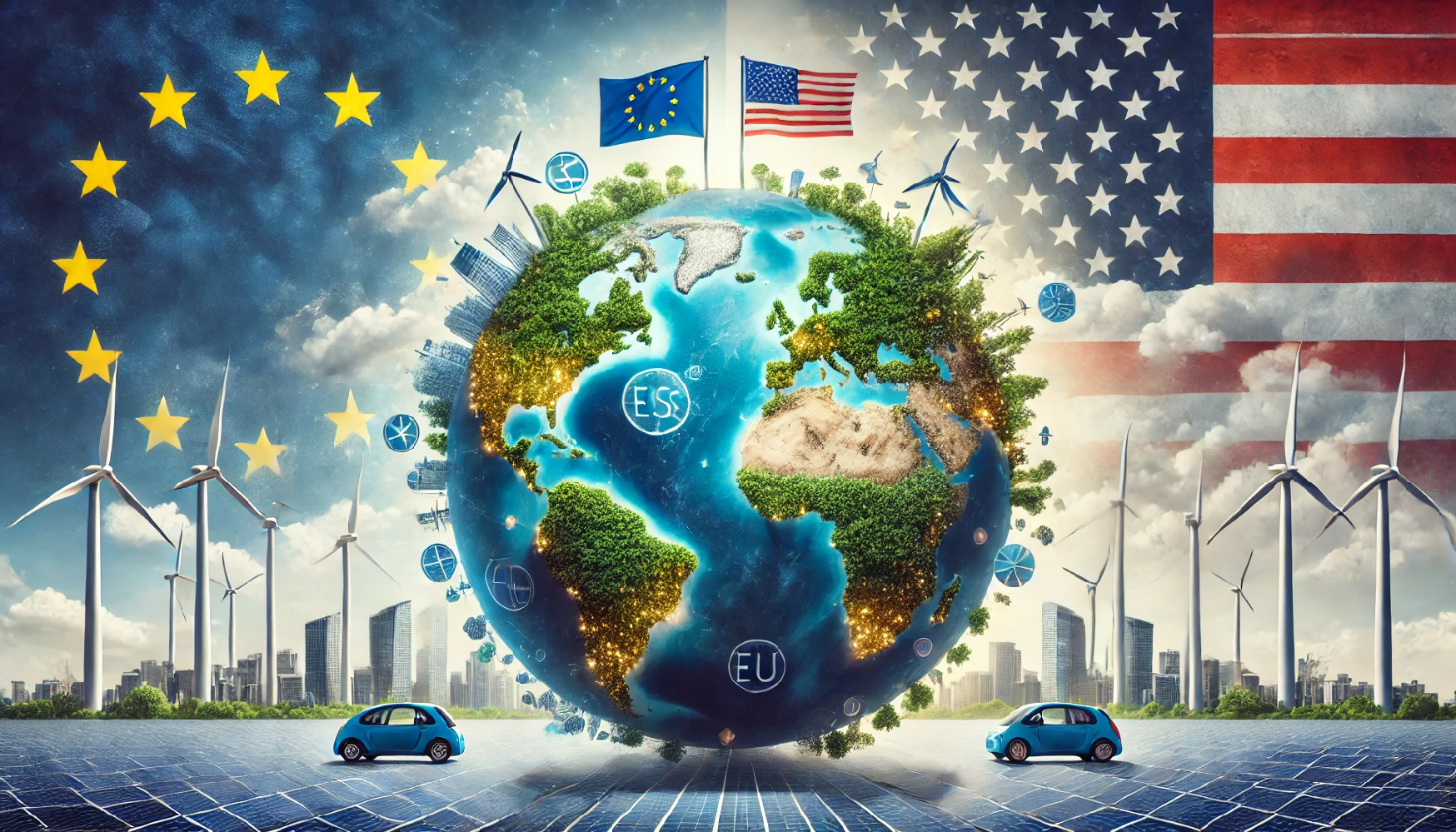
A Transatlantic Look at Future Green Political Priorities
As the global climate crisis deepens, leadership from both sides of the Atlantic is crucial in shaping the future of green policies. However, the clarity and urgency of these ambitions often vary, particularly within Europe. Ursula von der Leyen, who initially championed the European Green Deal as a cornerstone of her first term, seems to be recalibrating the EU’s climate focus. Although climate remains a priority, it no longer dominates the European agenda with the same level of ambition.
In contrast, the U.S. continues to grapple with a polarized political landscape in which the outcome of the next US presidential election will likely decide the country’s policy priorities for at least the next four years. Climate and energy policy are two areas where there is a fundamental difference of perspective between a potential Harris or Trump administration.
This comparison highlights common goals and differences as we look toward a future where global climate cooperation is an essential step toward a greening of global economic models.
The EU’s Regulatory Leadership: Climate Ambition on a Global Stage
The EU has long positioned itself as a global leader in climate action, driven by the European Green Deal, which aims for net-zero emissions by 2050. This ambitious agenda is supported by key political figures:
- Teresa Ribera: Recently nominated for the newly created role of First Executive Vice President for the Clean, Just, and Competitive Transition. If confirmed, she would oversee climate goals including the Clean Industrial Deal and regulatory competition through mechanisms such as the Emissions Trading System (ETS) and the Carbon Border Adjustment Mechanism (CBAM). The ETS aims to set a carbon price to incentivize emission reductions, while the CBAM ensures that imported goods meet EU carbon standards, thus preventing carbon leakage and promoting fair competition. Ribera’s mission reflects her deep commitment to advancing Europe’s leadership in climate neutrality and industrial competitiveness.
- Wopke Hoekstra: Proposed as Climate, Net Zero, and Clean Growth Commissioner, Hoekstra’s role would be crucial for achieving the EU’s net-zero target by 2050. He would be responsible for the Fit for 55 legislative package, which aims to cut emissions by 55% by 2030. Hoekstra would also focus on strengthening international climate partnerships and ensuring that Europe leads in renewable energy and clean technology development. His role underscores Europe’s commitment to global climate leadership and innovation.
- Jessika Roswall: As proposed Commissioner for Environment and Circular Economy, Roswall’s potential role would address critical environmental issues. Her mission would include enhancing water management to boost resilience against climate impacts and promoting a circular economy to reduce waste and improve resource efficiency. This involves supporting sustainable practices and industries that prioritize recycling and product longevity.
These appointments, pending approval, promise a multi-faceted approach to Europe’s climate strategy. However, the European Commission’s structure remains fragmented, with various Commissioners overseeing different sustainability initiatives. This fragmentation raises concerns about leadership clarity and accountability in driving the green agenda.
The U.S. Approach: A Tale of Two Countries
The U.S. climate strategy will vary significantly depending on the outcome of the U.S. presidential election in November. The American people will decide between two candidates, one of whom believes there are economic benefits to a greener climate transition and the other who intends to “Unleash [America’s] Energy Dominance” through an expansion of traditional energy sources. Here is a brief summary of each candidate’s respective strategies:
- Kamala Harris (Democrat): As Vice President, Harris supports the Inflation Reduction Act, a landmark climate measure that focuses on market-driven solutions. This act incentivizes renewable energy through tax credits and subsidies, reflecting a pragmatic approach to climate action within a politically constrained environment. Harris’s strategy emphasizes incremental progress and economic balance, particularly important in fossil-fuel-dependent regions.
- Donald Trump (Republican): Trump’s climate policy presents a stark contrast, emphasizing deregulation and fossil fuel expansion. His “America First” approach includes withdrawing from international agreements like the Paris Accord and scaling back renewable energy initiatives. Trump’s policies favor traditional energy sources such as coal and oil, which could lead to significant divergence from the EU’s regulatory strategies and create potential friction in transatlantic relations.
Commonalities:
- Commitment to Climate Action: Both the EU and current U.S. administration recognise the urgency of addressing climate change and have set ambitious targets. The EU aims for net-zero emissions by 2050, while the U.S., under Biden and Harris, has committed to significant emissions reductions through the Inflation Reduction Act (IRA). This shared commitment highlights the global recognition of climate change as a critical issue. In contrast, if Trump wins the election, he has pledged to rescind unspent funds under the Act labelling it the “Green New Scam.”
- Support for Clean Technology: Both regions are investing in clean technologies. The EU focuses on innovations like green hydrogen and electric vehicle batteries through its regulatory frameworks, while the U.S. promotes these technologies via market incentives and subsidies. Both approaches aim to accelerate the transition to renewable energy and foster technological advancements. Whereas Trump has pledged to terminate the IRA including its associated investments in renewable energy. Instead, he will support the competitiveness of U.S. industries focused on fossil fuels. It was during his first year as president in 2018 that the United States became the world’s largest oil producer – a position it continues to hold to this day.
- International Cooperation: The EU and U.S. both emphasize the importance of climate diplomacy. The EU’s strategies align with global climate frameworks, and the U.S., under Biden and Harris, supports multilateral alliances and the integration of environmental goals into trade agreements. This alignment underscores a shared commitment to global climate cooperation, despite differences in approach. However, this commitment will likely become one-sided during a potential Trump administration as he has stated he will once again pull the U.S. out of the Paris climate accord, as he did in 2020.
Divergences:
- Regulatory vs. Market Approaches: The EU employs a regulatory-driven approach with mechanisms like the Emissions Trading System (ETS) and the Carbon Border Adjustment Mechanism (CBAM). to enforce emissions reductions and carbon pricing. In contrast, the U.S., under Harris, would rely on market-driven solutions through subsidies and tax credits. These differing approaches reflect distinct strategies for achieving climate goals, which could lead to tensions, especially over carbon tariffs and competitive dynamics in clean energy industries. While under Trump this tension may be exacerbated as the U.S. will look to expand usage of traditional fossil fuels with an emphasis on regulatory rollbacks and reduction of renewable energy policies.
- Political Constraints and Implementation: The EU’s climate strategy benefits from a more unified political landscape, enabling ambitious regulatory measures. Conversely, the U.S. faces significant political fragmentation, with climate policies varying widely depending on the administration. This fragmentation complicates the implementation of comprehensive climate measures and creates challenges for maintaining consistent climate policies.
- International Stance: While both regions currently support international cooperation, their approaches diverge. The EU’s regulatory framework sets global standards for carbon emissions and pricing, whereas the U.S.’s approach, particularly under Trump, may shift towards isolationism and deregulation. This divergence could impact global climate agreements and affect transatlantic relations.
Global Implications
The divergent climate strategies of the EU and U.S. have substantial global implications, shaping international climate policies and trade dynamics.
The EU’s ambitious regulatory measures, such as the ETS and CBAM, are likely to set influential global standards for carbon pricing and emissions reductions. By enforcing strict carbon regulations, the EU could drive global industries to adopt similar standards to maintain access to the European market. This regulatory leadership could encourage other nations to enhance their climate policies, aligning with the EU’s framework to avoid trade barriers.
Conversely, the U.S.’s market-driven approach, particularly through the Inflation Reduction Act, is fostering rapid advancements in clean technologies. This focus on incentives and subsidies may stimulate innovation and competition in renewable energy sectors. However, it also raises concerns about potential competitive imbalances. European industries might view U.S. subsidies as creating an uneven playing field, which could lead to disputes over fair market access and trade practices. Whereas during a Trump presidency, the EU may find themselves the global leader on green policies.
At Trilligent, our teams on both sides of the Atlantic are well-positioned to help clients navigate these varying political landscapes. Whether aligning with U.S. policies or leveraging Europe’s green leadership, our expertise ensures you can adapt to and benefit from the evolving global climate framework.
RELATED ARTICLES


)


